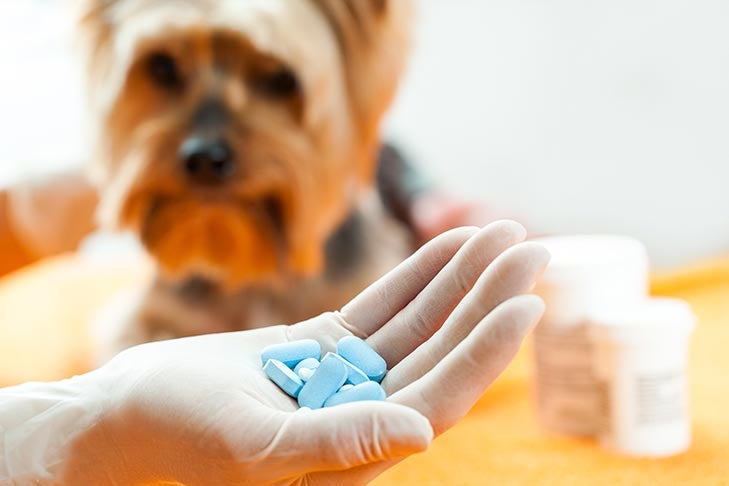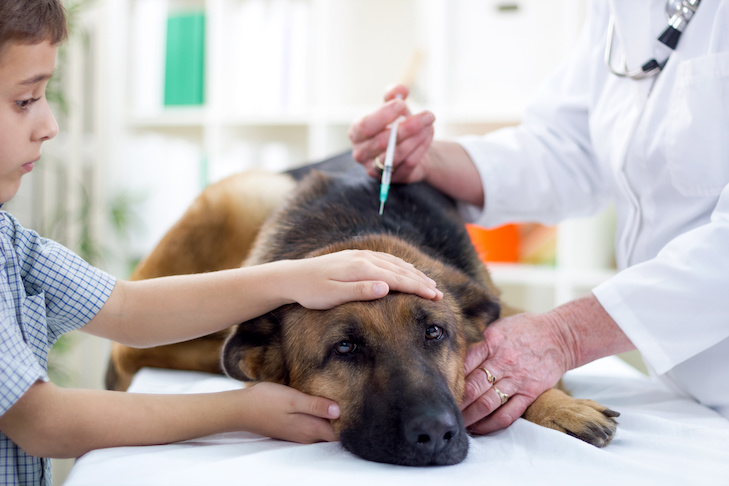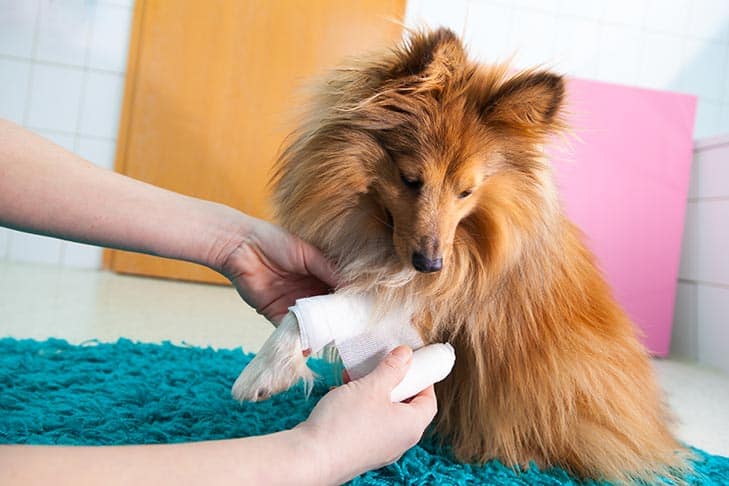If your dog has been bitten by a snake, what do you do? Taking action quickly is important, but try not to panic. Few snakebites on dogs prove fatal before you get to the emergency veterinarian, but it depends on the size of the dog, the type and size of the snake, if or how much venom was delivered, and where on the dog the bite is located. If you know (or even just suspect) that a venomous snake has bitten your dog, follow these guidelines:
What to Do If a Venomous Snake Bites Your Dog
Call your veterinarian or local emergency veterinary clinic immediately, let them know your dog was bitten by a snake, and ask if they carry antivenom. If you have to, drive to a clinic that’s further away if it means your dog will have access to antivenom. Antivenom works best when given immediately, but it is still effective hours, and even days, after a bite.
Ask questions about the veterinary treatment protocol. Proper care should include bloodwork to monitor severity, opioid pain medications, and possibly antivenom. If the veterinarian suggests Benadryl, NSAIDs, or steroids, discuss the Unified Treatment Algorithm for crotalid snakebites (applicable to both people and dogs) with them. Intravenous (IV) fluids and hospitalization for eight to 48 hours may be recommended as well.

The same holds true if the veterinarian refuses to give antivenom because of fear of allergic reactions (rare and reversible), the belief that antivenom can only be given once in a dog’s life (untrue), or that antivenom is only useful if given within an hour or two (also untrue, but the sooner antivenom is administered, the better). Direct them to the Unified Treatment Algorithm and advocate for your dog.
If you live in an area where snakebites are common, join the National Snakebite Support Group on Facebook. This group is manned by the top snakebite experts in the country for both humans and animals. Experts in the group can give you personalized advice as you work through a treatment plan with your vet or emergency clinic. By reading about other cases, you can be better prepared to deal with your own dog’s snakebite.
Snakebite treatment can be costly, from hundreds to thousands of dollars. With the possible exception of your own longtime veterinarian, it’s extremely unlikely that a veterinary emergency clinic will treat your dog without payment upfront. Many clinics do offer financing through CareCredit. You can call ahead and find out if they offer this or other payment options. It’s also wise to be prepared with pet insurance to help cover such unexpected costs in the future.
Effective Venomous Snakebite Treatments
Not all dog snakebite treatments are created equal. The following treatments are effective for treating venomous snakebite on dogs.
Antivenom
Antivenom (or antivenin) is the only treatment that can directly fight the effects of snake venom. Antivenom binds to the toxin and prevents it from damaging tissue cells. Antivenom is costly: around $400 to $800 a vial. Most dogs will receive one vial, but many will need two or several.
It takes about an hour to infuse one vial of antivenom intravenously. Not every dog bitten by a venomous snake needs antivenom. Many dogs that would benefit from antivenom can survive without it, but they will have much more severe and long-lasting pain and swelling. Bloodwork can determine how bad the envenomation (i.e., exposure to venom) is, giving the veterinarian a measure of how much the venom has compromised the dog’s blood clotting ability or various organs, and whether antivenom is needed.
Opioid Pain Medication
Snakebites are extremely painful. Even if your dog doesn’t need antivenom, or you can’t afford it, the veterinarian should administer an opioid injection for pain, and send you home with strong oral pain medications. NSAIDs (Non-Steroidal Anti-Inflammatory Drugs) like carprofen are unlikely to be adequate.
Ineffective Venomous Snakebite Treatments
Some veterinarians may try to treat snakebite on a dog with the following remedies, but they have been determined to be ineffective. Avoid treating your dog’s snakebite with a vet that advocates for one of the below methods. If you rush your dog to a vet who uses these ineffective methods, your dog may not receive proper treatment for the bite, and you may spend hundreds of dollars on ineffective treatments. When you eventually can visit a vet who uses effective treatments, by that point it may be difficult to afford it, and the venom will have had more time to negatively impact your dog. Always call ahead and make sure the veterinarian has a proper treatment protocol for venomous snakebites in place.
- Tourniquet or Constriction Bandage: Avoid any technique that could confine the venom in one place, as most tissue injury occurs locally. If performed incorrectly, these applications can increase systemic venom absorption while still allowing significant local tissue damage.
- Sucking Out the Venom: Suction devices remove almost no venom following a bite (no more than 2%, according to one study). They also take time to use and may even concentrate the venom by suctioning out interstitial cell fluid.
- Antihistamines: Unfortunately, false information has circulated suggesting that diphenhydramine (commonly known by the brand name “Benadryl”) is effective against snakebites. It isn’t. Diphenhydramine is an antihistamine, but histamine is not a major component of snake venom. The swelling from venom occurs because of cell leakage, not histamines.
- Electric Current: This is not an effective treatment for snakebite.
- Ice: Ice confines venom to the area of the bite, increasing local damage.
- NSAIDs to Control Pain: NSAIDs aren’t strong enough to combat the pain of snakebite for a dog. Snake bites already adversely affect clotting, and NSAIDs also increase bleeding tendencies.
- Corticosteroids to Control Swelling: Even if administered by well-meaning veterinarians, corticosteroids are of no value when treating snakebite in dogs. Corticosteroids don’t affect the toxins in snake venom and the redness, swelling, and pain they cause.
- Subcutaneous Fluids: Once again, subcutaneous fluid administration (administering fluids beneath the skin) could do more harm than good to your dog. Venom increases bleeding and bruising, as does subcutaneous (also referred to as “SQ” or “Sub-Q”) fluid administration, and IV fluids are needed for precise delivery.
- Antibiotics to Prevent Infection: These are often prescribed but rarely needed. It’s rare for snakebite on a dog to become infected. If it does, your vet will then treat the subsequent infection.
- Rattlesnake Vaccine: This vaccine is ineffective. In a study of 82 canine snakebite victims, 14 subjects that had received the rattlesnake vaccine did have a lower morbidity rate, but that result was not statistically significant. Vaccinations work by priming the immune system to make antibodies when it encounters the first invaders: before those invaders can multiply enough to make you sick. However, a snakebite introduces a huge amount of “invaders” all at once. It takes time for the immune system to react and produce cells to fight invaders. Even a vaccine can’t react quickly enough to make a difference with a snakebite.

Signs of Venomous Snakebite in Dogs
Besides possible wounds, dogs can exhibit several other signs of snakebite. Venomous snakebites are extremely painful. While some dogs are very stoic and will hide their pain, others may react by crying and hiding. Very often they will vomit and have diarrhea soon after the bite. Swelling may appear within minutes, followed by bruising. But either could also come on more slowly.
Can I Treat My Dog’s Venomous Snakebite With First Aid?
No. If your dog was bitten by a venomous snake, the only thing you can do is remove the dog’s collar, keep your dog calm, and head to the closest emergency vet that has antivenom. If you are hiking, carry your dog to your car if you’re able to. If possible, have somebody meet you along the trail to pick you up.
If you saw a common non-venomous snake (like a garter snake or a ribbon snake) bite your dog, you should still contact your vet, as even non-venomous snake bites can become infected if left untreated. If you’re unsure at all if the snake was venomous, you should contact your vet immediately.
What If I Didn’t See the Snake That Bit My Dog?
It’s very common for dogs to be bitten and then run away from the snake, and you may never see the snake that bit your dog. If you have other dogs, get them under your control immediately so they aren’t also at risk of a bite. But you don’t need to identify the snake that delivered the bite in order to treat the dog, just get your dog veterinary help.
If the dog shows signs of envenomation, it doesn’t matter whether a rattlesnake, water moccasin, or copperhead was the culprit. All North American pit viper bites are treated the same way, with the same antivenom. Coral snake bites, however, have different signs and potentially different treatment.
How Bad Is My Dog’s Snakebite?
There are many types of snakes, so it can be difficult to assess the severity of the snakebite on your dog. If you live in an area with a known venomous snake population, you may want to familiarize yourself with signs of venomous snakebite and the ways to distinguish different bites. If your dog is exhibiting signs of being bit by a venomous snake, you should treat it as if it’s a venomous bite and contact your veterinarian or emergency clinic.
We’ve all seen the double-puncture marks that are the signature of a snakebite. But snakebites don’t always look like that. Sometimes only one puncture is visible; sometimes three or more are visible if the snake has bitten repeatedly. In longhaired dogs, you may not see anything at all until the fur is shaved. And some bites bleed profusely, obscuring any marks. So any kind or number of puncture wounds, dry or bloody, could be from a snakebite.
Are Some Snakebites More Dangerous Than Others?
Copperheads are less venomous than water moccasins, which are in turn less venomous than rattlesnakes. Larger snakes can deliver more venom than smaller snakes. But bites from any venomous snake warrant a trip to the emergency vet.
Bites to areas of a dog’s body with lots of blood vessels (“highly vascularized” in vet-speak) are more dangerous than those to less vascularized areas. Bites to the trunk are more serious than those to the face. Bites to the tongue are extremely dangerous, as are bites that land directly into an artery. But every venomous snakebite is unique. Treat each one as though it were the worst case.
What Is a “Dry Bite,” and How Can I Tell?
Ask the veterinarian who is treating your dog if the snakebite was a “dry bite,” but don’t try to assess it yourself. Up to 15% of bites from pit viper (one category of venomous snake) bites are so-called “dry bites.” A dry bite is a snakebite in which no venom was injected. “Snakebites are a dynamic process,” says Dr. Spencer Greene, MD, a medical toxicologist and emergency physician who specializes in snakebites.
Greene objects to possibly labeling a bite as “dry” because it has little or no swelling after a short amount of time. “Patients who may have been bitten by a venomous snake should be observed for at least eight hours,” he says. “If there are no local findings, no systemic toxicity, and no hematologic lab abnormalities, then it is reasonable to make the diagnosis of a dry bite. To call it a dry bite after one hour of observation is a recipe for disaster.” Leave this to the experts.
What If My Dog Is Bitten by a Coral Snake?
First of all, don’t try to remember the coral snake rhymes about colors. Nobody gets it right, not even the snakes! If you saw the snake and you suspect it was a coral snake, if it’s possible and safe to do so, take a picture of the snake to show to the vet, but don’t waste valuable time if you don’t know where the snake went. The farther east the species resides, the more venomous its bite. So in general, Florida coral snakebites are more deadly than Texas ones. Although up to 25% or more of coral snakebites don’t contain toxins, those that do can be deadly.
Coral snake envenomation does not result in local swelling or bruising. The toxin acts on the nervous system, causing numbness and paralysis, starting with the extremities and working toward the trunk. Pit viper antivenom doesn’t work for coral snakebites. Coral snake antivenom is available but is very difficult to get. The antivenom can stop the advancement of paralysis but cannot reverse it.
If your dog is bitten by a coral snake, you should try to take them to a veterinary teaching hospital, or advanced veterinary ER for observation. A coral snake bite can take two hours for signs to show up. The problem is, once paralysis reaches the diaphragm, the dog won’t be able to breathe and will need to be placed on a ventilator to survive. Fortunately, with supportive care, and especially with administration of coral snake antivenom, most dogs will survive.

Are Some Dogs at Greater Risk for Snakebite?
The smaller the dog, the greater the risk. Very young, old, or debilitated dogs may also be at greater risk. Flat-faced dogs can also be at greater risk. According to National Snakebite Support Group veterinary expert Dr. Katherine Anne Crocco-Khan, DVM: “If your flat-faced dog is bitten by a venomous snake, especially to the face, it is extremely important to advocate for antivenom even with normal lab parameters.” Facial swelling could be dangerous for these breeds in particular. She adds, “I would also argue that it is more important for these breeds to stay hospitalized for monitoring in case there is any sign of respiratory distress, as it is important to be able to intubate to secure an airway if the swelling gets to the point of causing an upper airway obstruction.”
How Can You Help Prevent Snakebite on Dogs?
Know which venomous snakes are common in your area, or in an area that you’re planning to visit with your dog. Clear your yard of fallen logs, trash, and deep leaf litter. Don’t let your dog stick their head in holes, bushes, or tall grasses. Snakes are more active after dark and in warm weather, so keep your dog inside after dusk when you know venomous snakes are in the area. Rattlesnakes and copperheads prefer dryer areas, and water moccasins prefer wet areas, so be mindful of the different environments your dog likes to play, sniff, splash, or walk in when you’re outdoors in an area known to have venomous snakes.
Snakes frequent areas where they can find food. Popular prey for snakes are mice, rats, squirrels, and rabbits, so the more inhospitable your yard is to these animals, the less inviting your yard will be to snakes. You could also take steps to attract owls or hawks to nest on your property to help deter snake prey and snakes themselves. (Just know that birds of prey have their own considerations when keeping small dogs or puppies safe.)
Snake repellents (including commercial powders, liquids, and noisemakers, as well as home remedies like mothballs) are ineffective. Snake aversion training for dogs is available, especially in areas with high numbers of venomous snakes. If you live in an area where venomous snakes are a grave concern, you may want to learn how snake aversion training works by consulting a professional trainer who specializes in it to decide if it’s something you wish to consider.








